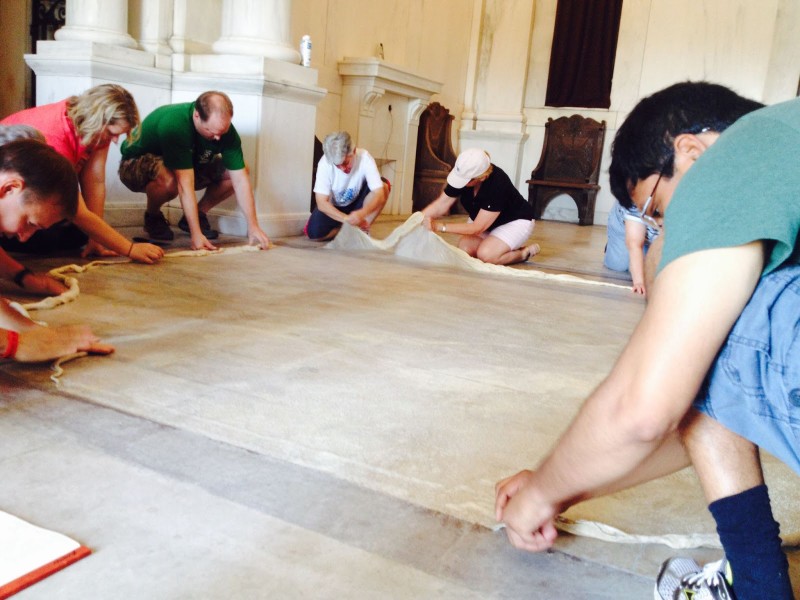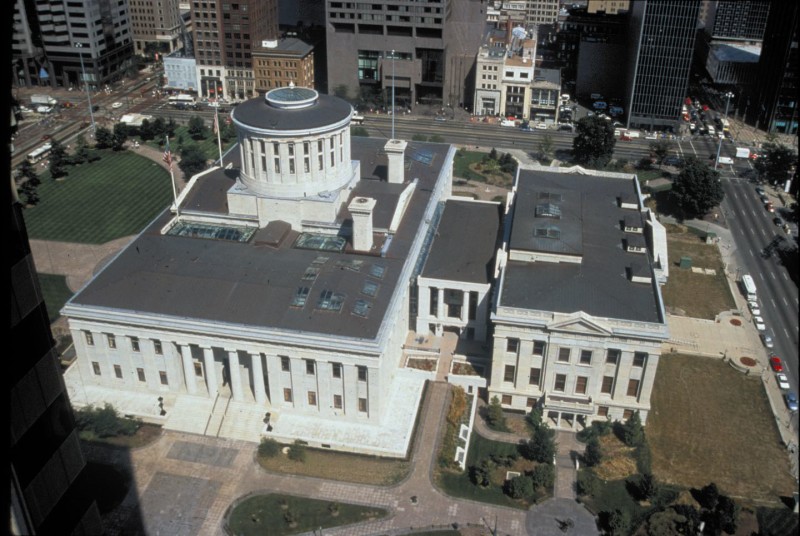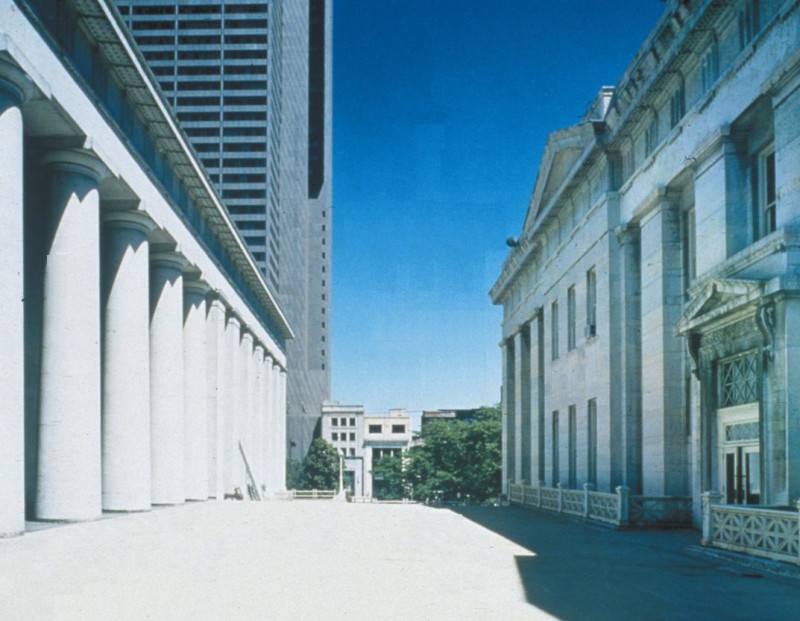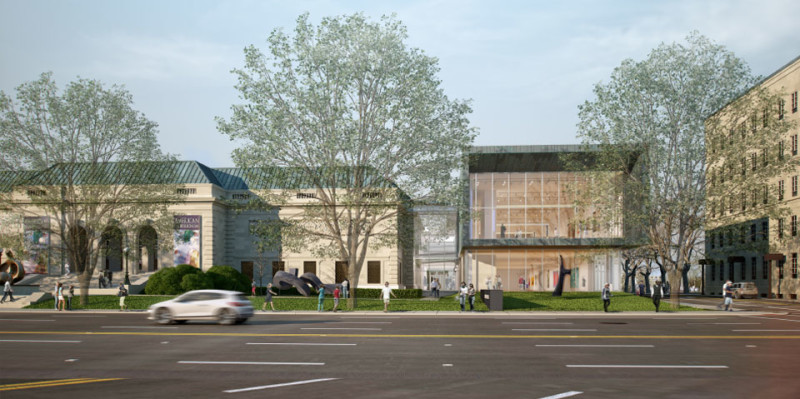Emerging Professionals Scholarship
It is back for the second year! Thanks to the continued support from Schooley Caldwell, this year will see the return of the Emerging Professionals Scholarship contest and conference session.
 Scholarship winners will receive the opportunity to present a mini-presentation on their preservation work, 2-nights at the conference hotel, up to $100 travel reimbursement, and complimentary conference registration. Winners will be announced in early August, and all applicants will receive early bird conference registration code if not selected. There are two scholarship opportunities for the 2017 Heritage Ohio Annual Conference.
Scholarship winners will receive the opportunity to present a mini-presentation on their preservation work, 2-nights at the conference hotel, up to $100 travel reimbursement, and complimentary conference registration. Winners will be announced in early August, and all applicants will receive early bird conference registration code if not selected. There are two scholarship opportunities for the 2017 Heritage Ohio Annual Conference.
No fee is required to apply, however, support from our members allows us to continue helping Ohioans to save the places that matter; build community; live better. Please consider joining here.
Proposals will be accepted until 5 PM on Friday, July 28th.
![]()
YOP Columbus Metropolitan Library Tour & Cocktail Party
Thursday, Aug 25, 2016 4:30 PM – 9:00 PM
The Columbus Metropolitan Library recently underwent a major renovation and we cannot wait to see the results! Join YOP for this tour and learn from the pros how the contemporary addition respected this beautiful historic library. The tour will be lead by Project Architect Brian Pawlowski, with Schooley Caldwell. It will take about an hour, and he will give a detailed description of the design decisions made.
The Parking Garage in the basement of the Library provides plenty of spaces, however there is a small cost. There is on-street parking also available. We will meet in the atrium in the Carnegie Library to begin our tour.
Following the tour, stroll over to a Town Street Garden Party hosted by Columbus’s leading preservationists, Jeff Darbee, Nancy Recchie, Bob Loversidge, Judy Williams, and Kate and Tom Matheny. Enjoy drinks and snacks, and a wonderful atmosphere you can only get in downtown’s historic corridor.
If you just want to tour the library with us, please register below. The tour is free, however, space is limited.
Please be sure to register for the cocktail party and take advantage of the opportunity to have a drink with leading professionals in historic preservation and architecture. If you are a paid YOP member then it is just $10. If you have not yet joined YOP it is only $35, which includes your $25 membership and all the benefits that come with it.
![]()
YOP Seventh Son Brewing Co. Happy Hour and Tour
Join the Young Ohio Preservationists for a happy hour at Seventh Son Brewing Co. on Thursday, April 14th! The staff will lead YOP on a private tour of the historic building, a prime example of adaptive reuse. On the corner of 4th and 4th in Italian Village, the brewery is located in a boomerang shaped building that housed an auto garage since the early 20th century. In 2012, Seventh Son Brewing Co moved into the building after extensive renovations, transforming it into a craft brewery with a bar, private tasting room, and patio. Happy hour is from 5:30 to 7:30, tour starts at 6. See you there!
![]()
OHC's SHPO looking to the future with publication of its 2016-2020 preservation plan
Our State Historic Preservation Office recently unveiled its most recent preservation plan. Finding Common Ground: A Historic Preservation Plan for Ohioans | 2016-2020 seeks to help steer the conversation, and, more importantly, guide the actions of preservationists across the state to achieve critical preservation goals over the next few years. You can download a copy of the plan here.
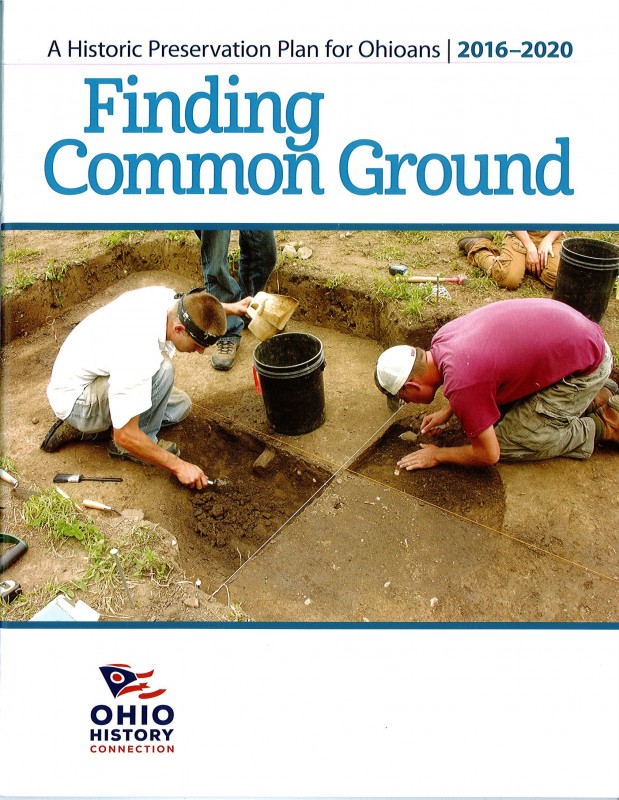
Cover of the historic preservation plan published by the State Historic Preservation Office
Being the preservation geek that I am, after I read through the plan, I rummaged around in my file cabinet and pulled out the previous preservation plan. I wanted to see how we’re doing when it comes to achieving the goals that we as Ohioans set for ourselves. There were six goals listed (and numerous opportunities under each of the goals):
Goal 1.Pay for preservation
Goal 2.Educate the public
Goal 3.Identify historic resources
Goal 4.Get involved
Goal 5.Lead!
Goal 6.Promote historic preservation
Under each of the six goals was listed a series of opportunities, and I’m happy to report, Heritage Ohio has played a role in furthering many of the opportunities listed in the previous plan. From our advocacy efforts at preserving and strengthening the state tax credit, to providing training to design review boards, to leading efforts to secure an economic impact study on the effectiveness of the state tax credits, we’re working on a day-in, day-out basis to move preservation forward.
And looking outside the context of the preservation plan, we have great initiatives we’ve launched independently. I firmly believe that Ohio’s next generation of preservation leadership resides within the Young Ohio Preservationists, and they have accomplished so much in just the past couple years. Our Save Ohio’s Treasures fund, when capitalized, will provide one of the few sources of brick and mortar loans for worthy preservation projects. Our Old House Fair, back for a second year in Medina in May, was launched to help give owners of old buildings a chance to network and learn from the artisans doing work on those old buildings. So, while we know that the work is never truly done, we’ve taken some important steps over the past few years in the name of preservation, and will continue to do so in the future.
So, take a look at the new plan, take a look at the goals, and let us know: what’s most important to you as an Ohioan? Where do you see opportunities for Heritage Ohio to help continue moving preservation forward over the next few years?
![]()
Heart Bomb 2016 just days away!
This year’s Valentine’s Day will include a first for Ohio: a coordinated statewide heart bombing of selected buildings. The Young Ohio Preservationists have partnered with Columbus Landmarks Foundation in Columbus, and with 13 different Main Street programs throughout Ohio to supply hearts for decorating historic buildings.
So, what exactly is heart bombing? The National Trust’s web site defined heart bombing this way: “It’s the act of showering an older or historic place with tangible expressions of affection and devotion–preferably with lots of other place-lovers in tow.”
Heart bombing the buildings you love is a great way to call attention to their plight, if vacant/underutilized, or to celebrate the historic buildings that provide your community’s sense of place.
Thanks to YOP for taking the lead on this visual celebration of historic buildings in our state, and the people who love them!
(You can keep up on all the goings-on during Heart Bomb 2016 by visiting the YOP facebook page here.)
![]()
YOP Land Grant Brewery Tour and Happy Hour
The Young Ohio Preservationists are hosting an exclusive tour and presentation by Blake Compton, CEO of Compton Construction, LLC about the making of Land-Grant Brewing Company!
The space had previously been an elevator factory prior to the change of use renovation. The building was transformed from top to bottom into what has become a destination brewery in Franklinton. The building now features reclaimed materials, including locally harvested barn wood, along with custom features that make it a one of a kind space.
Join us for drinks at the brewery following the tour!
![]()
Wonderful Wood Windows!
Here in central Ohio we’ve had our first real blast of winter over the last couple of days…snow flurries, temperatures in the 20s, teeth-chattering winds, the whole nine yards. And, if you live in an old house with wood windows (like I do), you’ve likely felt that wintry reminder when passing by one of those windows.
So, maybe it was just a wintertime coincidence (or destiny) that one of the first emails from a concerned Ohioan to Heritage Ohio in 2016 brought a plea for help, requesting assistance to convince the owner of a historic building not to dump their original wood windows.
As you can imagine, this is one of the most common email discussion roads we go down. Too often, this is what we find: building owners ready to toss their original sash because they don’t function. The sash are painted shut; the sash, if opened, don’t stay up (the sash cords broke long ago); or, as in my case, when you walk by the window in the dead of winter, you can feel the breeze inside the building. In that case, weatherstripping is the issue.
While solving any of these window issues isn’t especially difficult, too often, the owner freezes once that thought, “the hassle of repair,” goes through their mind, and they reach for their tablet to google “window replacement.”
There has been a lot of marketing from the replacement window industry extolling the virtue of replacement windows. When it comes to windows, we’ve gone through a good 40 years of purging the word “maintenance” from our collective consciousness, while the window replacement industry has trained people to believe that the “hassle” of repair is a fate worse than death.
To counter this, we preservationists have begun promoting the value of preserving original windows with groups such as the Window Preservation Alliance. And the National Trust has recently put a greater focus on quantifying the value of wood windows, why preserve, and how best to preserve. Their report, Saving Windows, Saving Money, has been especially helpful for us. The report quantifies the energy savings, cost, and return on investment for a variety of window treatments, including weatherstripping, installing an exterior storm, and installing a new high performance replacement window. And guess what they found? DIY weatherstripping offers an average 31% return on investment, while DIY high performance replacement windows offer a 3% return on investment.
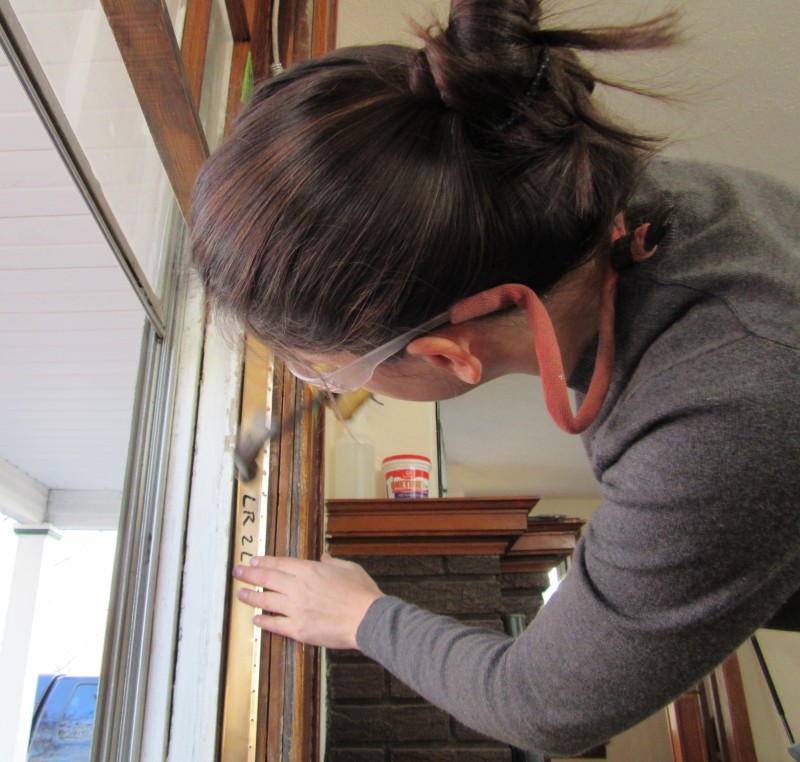
That shiny stuff Rebecca Torsell is nailing onto the jamb may be bronze, but when it comes to energy efficiency, it’s worth its weatherstripping weight in gold.
And this is exactly why YOP offering their hands-on window repair training last year in Columbus was so valuable: giving homeowners the skills to tackle DIY projects such as window repair and weatherstripping SAVES MONEY, while saving the architectural integrity of their homes, while saving money on the heating bill.
Now if only we had the billion dollar marketing budget to get THAT message out!
![]()
Holiday Gift Ideas for the Preservationist
The downtown main streets are covered in lights and there are wreaths on all the historic houses, which means it’s that time of year when you’re trying to find the perfect gift for the preservationist in your life. What do you get for that nerd who has such specific tastes? Here’s a handy guide to give you some ideas for the holiday season!
Olloclip
Olloclips are clip-on lenses for your iPhone that give you a 4-in-1 option per kit. Perfect for your preservationist who spies a gorgeous building while out on a jaunt and needs to snap a high-quality photo for their Instagram.
Coonley Tumblers
Your preservationist can enjoy his or her favorite beverage in these glass tumblers that have beautiful detailing from the Avery Coonley Playhouse triptych in Riverside, Illinois.
Gift Membership to the National Trust
Give a gift membership to the National Trust for Historic Preservation and your preservationist will receive discounts for accommodation and admission to National Trust sites worldwide. He or she loves discounts!
Aminimal Studio GPS Jewelry
Using GPS information from OpenStreetMap, Brooklyn-based Aminimal Studio has created a line of urban jewelry and dog tags of urban grids from around the world to help your preservationist look stylish.
Red Rabbit Republic Prints
Help your preservationist decorate their place with these beautiful prints from Etsy seller Red Rabbit Republic. They’re printed on fibre-based 285gsm Hahnemuhle Torchon – an acid-free, archival fine art paper of museum standard that lasts for centuries.
Happy shopping and happy holidays from the Young Ohio Preservationists!
Article by Nimisha Bhat
![]()
YOP Green Lawn Abbey Marble Cleaning Workshop Recap

YOP members (left to right) Sarah Marsom, Nimisha Bhat, Kalpa Baghasingh, Pearl-Jean Mabe, & Michael Blau.
Built in 1927 by the Columbus Mausoleum Company, Green Lawn Abbey is a neoclassical mausoleum listed in the National Register of Historic Places and has been undergoing a restoration for a number of years. With 1½“ thick granite walls, marble interior and an imported tile roof, it still impresses with its regal structure and beautiful stained windows. Over the years, the Abbey’s foyer floors have accumulated large areas of badly stained marble from years of organic and metallic damage.
Enter Community Partnership Grants Coordinator for the City of Columbus and fearless leader Kate Matheny. Kate has dedicated herself to restoring Green Lawn Abbey to make it into a usable space for programming, and successfully acquired CLG grants and other opportunities to preserve this historic structure. The Young Ohio Preservationists worked with the Green Lawn Abbey Preservation Association to coordinate a workshop in order to learn about and do some hands-on marble cleaning on July 25th. Kate, her husband Tom of Schooley Caldwell Associates, and Matt Wolf of the Centennial Preservation Group kicked the workshop off by giving a history of the building and its structure. The workshop volunteers learned about different types of marble, how the Abbey’s preservation management plan was created, and the basic process behind marble restoration.
After surveying the test area set aside for cleaning, volunteers got a brief explanation from Matt about the type of poultice being used on the marble. The poultice, once applied, thickens over time and basically pulls up stains and dirt from the marble. The poultice had been applied a little over 24 hours prior to the workshop, and no one quite knew what the results would be. Workshop volunteers then rolled their sleeves up and got to work, removing the poultice as a team by peeling it back slowly. Wet rags and water were then used as an additional measure to remove any remaining dirt that had been brought up by the poultice.
Volunteers discovered a 75% improvement after all the cleaning efforts, and it was decided that the marble would look shiny and new after a few more applications of the poultice and a little more elbow grease!
To become involved in future restoration events at Green Lawn Abbey, keep an eye out on the Green Lawn Abbey website and their Facebook page.
For more pictures check out the album on YOP’s Facebook page
Article by Nimisha Bhat
![]()
Preservation Month Photo Contest | And the winner is…
Thank you to everyone who voted this year, and congratulations to Judith Khaner, this year’s winner!
Judith’s winning image features the interior of the Arcade, a Cleveland landmark revitalized for shops and hotel use in the early 2000s. As this year’s winner, Judith’s image will be featured on a future issue of Revitalize Ohio.
Whether entering our contest or voting for a winning entry, we hope you’ll join us next year for Preservation Month for our 2016 Photo Contest.
Here’s Judith’s winning entry:
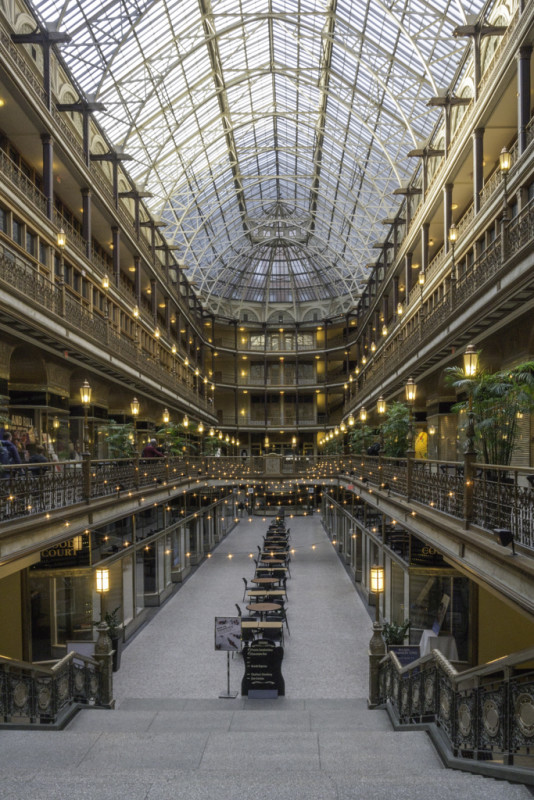
Sensitive Additions To Historic Buildings: A Primer
By: Kalpa Baghasingh
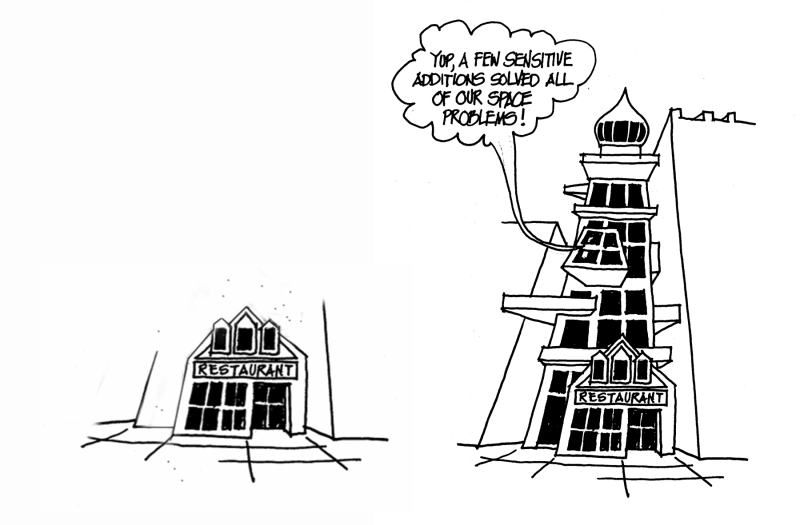
Sketch by: Jeff Gordon, AIA, Former Director of Design at Schooley Caldwell Associates, drawn for Sympathetic Additions to Historic Buildings, 2012 AIA lecture, by Robert Loversidge, FAIA, President and CEO, Schooley Caldwell Associates
Additions are one of the trickiest aspects of working with a historic building. Additions are often required for programmatic reasons. The National Park Service (the agency that develops historic preservation policy and guidance on preserving and rehabilitating historic buildings) advises that “an exterior addition should be considered once it has been determined that the new program requirements cannot be met within the existing building envelope.” Sometimes the available square footage and configuration of spaces do not meet the needs of a proposed use, and sometimes an addition is warranted to account for expansion of the current use. Many times, an addition helps in extending the life of a historic building, which would otherwise have been in danger of being abandoned or demolished for being infeasible of supporting modern uses.
Additions can be as small as an entry vestibule, or as large as entire buildings. In any case, designing an addition is a delicate balancing act–the addition should be compatible with the historic building, but should also be distinguished enough so as not to offer a false impression of being historic. In a nutshell, respect the historic building, but don’t try to pass off an addition as old. It’s no wonder then that an addition often invites opposing design philosophies and controversy.
So, what is a “sensitive” addition? The National Park Service (NPS) has published guidelines, which strives to answer this very question, and provides a sort of checklist to help achieve it:
- A new addition should be simple and unobtrusive in design, and should be distinguished from the historic building in a manner that makes clear what is historic and what is new.
- A new addition should be constructed in a way that there is the least possible loss of historic materials and so that character-defining features are not obscured, damaged, or destroyed.
- A new addition should not be highly visible from the public right of way; a rear or other secondary elevation is usually the best location for a new addition.
- The construction materials and the color of the new addition should be harmonious with the historic building materials.
- The new addition should be smaller than the historic building—it should be subordinate in both size and design to the historic building.
You can read the entire Preservation Brief #14 here.
Let’s look at a couple local examples now. The first example is a classical addition at the Ohio Statehouse, and the second one is a more modern addition at the Columbus Museum of Art.
Ohio Capitol Atrium Connector
Architect: Schooley Caldwell Associates
The Ohio Capitol Atrium was added as a connector between the Ohio Statehouse (1838-1861) and the Senate building (1899-1901) in 1993. The space was a walkway between the two buildings, and is now used as a space for conferences and special events. The addition is compatible with the neoclassical style of architecture of the Statehouse. The façade is set back from the front, and the scale is subordinate to the parent buildings. The addition looks different enough to not be confused with the historic buildings
You can read a brief history of the Connector here
Columbus Museum of Art Expansion
Architect: Design Group
This ongoing expansion project at the Columbus Museum of Art has an interesting bold design as its addition. Its minimalistic yet soaring design contrasts with the historic building, but also borrows from it. The pre-patinated copper and limestone façade has clearly been inspired by the historic building. The two-story addition is tied to the historic 1931 museum building by a recessed glass connector, which protects the integrity of the original building. This definitely pushes the boundaries of conventional “rules” regarding sensitive additions, but also emphasizes the fact that there is no one right answer when it comes to sensitive additions.
You can read more about the expansion project here:
In summary, a sensitive addition should strive to:
- Preserve the historic character and integrity of the property.
- Preserve significant historic materials and features.
- Protect the historical significance by making a visual distinction between old and new.
- Be compatible to the historic scale, mass and form.
- Be reversible.
So, the next time you come across a historic building, try figuring out if it was added on to. Or if you are looking to construct an addition to your vintage house, consider these guidelines before moving ahead.




